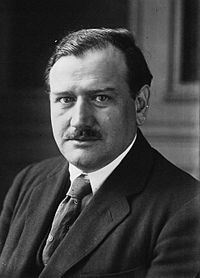Daladier
| Édouard Daladier | |
|---|---|
 |
|
| 72nd Prime Minister of France | |
|
In office 10 April 1938 – 21 March 1940 |
|
| President | Albert Lebrun |
| Preceded by | Léon Blum |
| Succeeded by | Paul Reynaud |
|
In office 30 January 1934 – 9 February 1934 |
|
| President | Albert Lebrun |
| Preceded by | Camille Chautemps |
| Succeeded by | Gaston Doumergue |
|
In office 31 January 1933 – 26 October 1933 |
|
| President | Albert Lebrun |
| Preceded by | Joseph Paul-Boncour |
| Succeeded by | Albert Sarraut |
| Minister of Defence | |
|
In office 4 June 1936 – 18 May 1940 |
|
| Prime Minister |
Léon Blum Camille Chautemps Himself |
| Preceded by | Louis Maurin |
| Succeeded by | Paul Reynaud |
|
In office 18 December 1932 – 29 January 1934 |
|
| Prime Minister |
Joseph Paul-Boncour Himself |
| Preceded by | Joseph Paul-Boncour |
| Succeeded by | Jean Fabry |
| Member of the French Chamber of Deputies | |
|
In office 2 June 1946 – 8 December 1958 |
|
| Constituency | Vaucluse |
|
In office 16 November 1919 – 10 July 1940 |
|
| Constituency | Vaucluse |
| Personal details | |
| Born |
18 June 1884 Carpentras, Vaucluse, France |
| Died | 10 October 1970 (aged 86) Paris, France |
| Political party | Radical |
| Spouse(s) |
Madeleine Laffont (m. 1917; her death 1932) Jeanne Boucoiran (m. 1951; his death 1970) |
| Children | Jean Pierre Marie |
| Education | Collège-lycée Ampère |
| Profession | Historian, teacher |
| Military service | |
| Allegiance |
|
| Service/branch |
|
| Rank | Captain |
| Battles/wars | |
Édouard Daladier (French: [edwaʁ daladje]; 18 June 1884 – 10 October 1970) was a French "radical" (i.e. centrist) politician and the Prime Minister of France at the start of the Second World War.
Daladier was born in Carpentras, Vaucluse. Later, he would become known to many as "the bull of Vaucluse" because of his thick neck and large shoulders and determined look, although cynics also quipped that his horns were like those of a snail. During World War I, he rose from private to captain and company commander.
A government minister in various posts during the coalition governments between 1924 and 1928, he was instrumental in the Radical Party's break with the socialist SFIO in 1926, the first Cartel des gauches – "Left-wing Coalition"), and with the conservative Raymond Poincaré in November 1928.
Daladier became a leading member of the Radicals. In 1932 he knew from German rivals to Hitler that Krupps was manufacturing heavy artillery and the Deuxieme Bureau had a grasp of the scale of German military preparations, but lacked hard intelligence of their hostile intentions. He first became Prime Minister in 1933, and then again in 1934 for a few days when the Stavisky Affair led to the riots of 6 February 1934 instigated by the far right and the fall of the second Cartel des gauches.
...
Wikipedia
